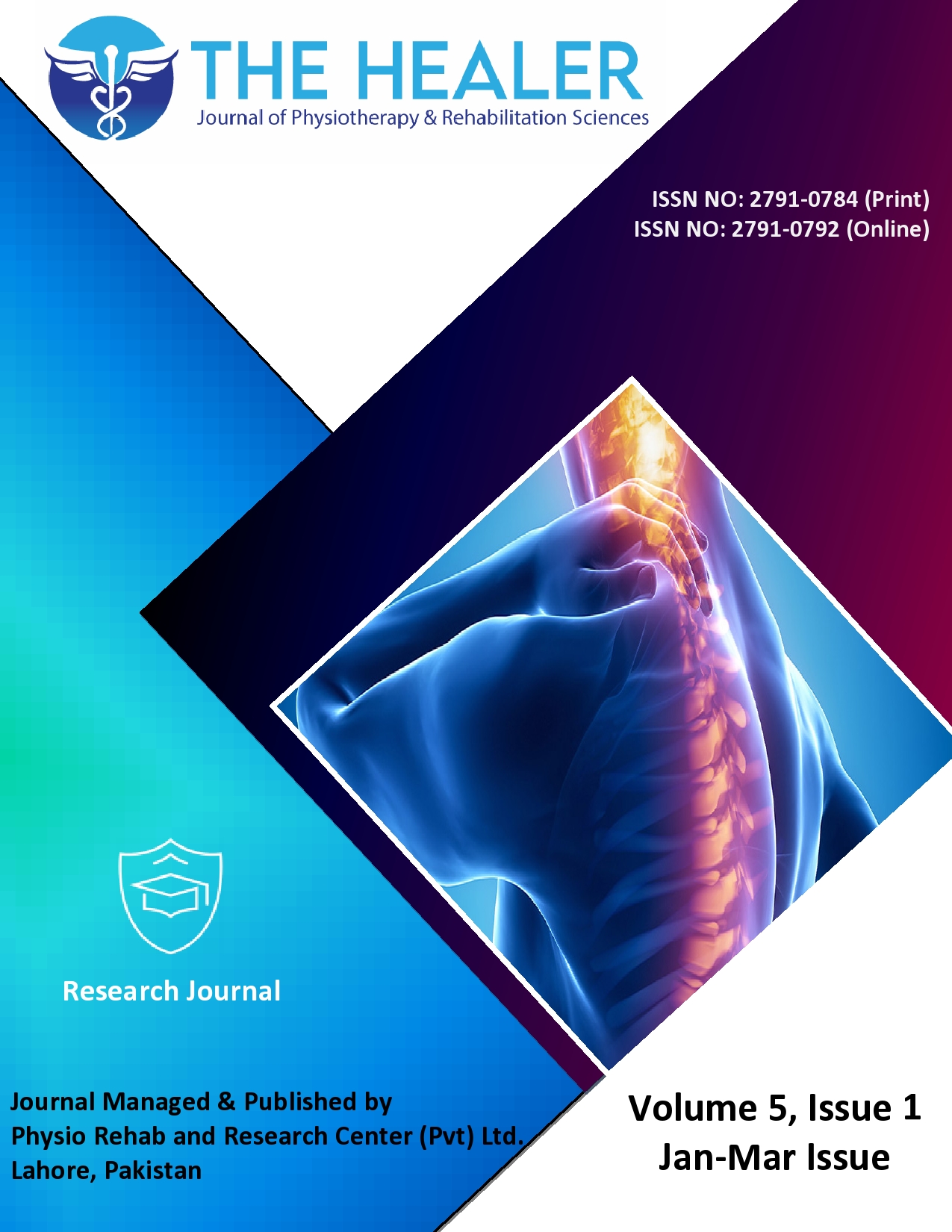Effects of Binaural Auditory Beats on Hand-Eye Coordination in Young Population
DOI:
https://doi.org/10.55735/3zkh4938Keywords:
Alternative wall toss test, Beta binaural beat , Binaural auditory beats , Eye-hand coordinationAbstract
Background: Binaural auditory therapy is one of the emerging fields of neuroscience with potential health benefits for the human brain. Many ranges of brain waves can be enhanced by the use of external auditory stimulus, which in turn augments brain activity. Objective: To determine the effects of beta binaural beats on eye-hand coordination in the young population. Methodology: This cross-sectional comparative study was conducted over 12 months from January 2023 to January 2024 at the Foundation University College of Physical Therapy, Islamabad, consisted of 66 healthy individuals aged 19-44 years of both genders, while exclusion criteria included conditions affecting sensory or cognitive function, physical limitations, regular cricket players, and other health issues that could hinder task performance. Data collection was initiated after obtaining approval from the Institutional Research Committee and Ethical Review Committee of Foundation University. Data was gathered using a self-structured questionnaire to screen participants and collect demographic details. Body mass index was calculated using weight and height measurements. The primary assessment tool was the Alternate Wall Toss test, where participants stood two meters from a wall and alternately threw and caught a tennis ball between hands for 30 seconds, with the number of successful catches recorded for eye-hand coordination scoring. The descriptive statistics, including means, frequencies, and percentages, were calculated to summarize participant characteristics. The Mann-Whitney U test was applied to compare medians, interquartile ranges, and assess statistical significance between groups. Results: In this study, there is a significant effect of beta binaural beats on eye-hand coordination in the young population, as the p-value was less than 0.05. By applying the Mann-Whitney U-Test, the Median of the level of coordination was 5.0, and its p-value was 0.02, so the results are significant and there is a positive effect of beta binaural beat on eye-hand coordination in the young population. Conclusion: It was concluded from the study that beta binaural beats have significant effects on eye-hand coordination of the young population. There exists a positive relation between the level of coordination and the male gender; males have an overall higher level of coordination than females.
Downloads
References
1. Moore BCJ. An introduction to the psychology of hearing: Brill; Emerald 2012. Online available at https://books.google.com.pk/books?id=LM9U8e28pLMC
2. Licklider JCR, Webster J, Hedlun J. On the frequency limits of binaural beats. The Journal of the Acoustical Society of America, 1950; 22(4): 468-73. DOI: https://doi.org/10.1121/1.1906629
3. Perrott DR, Nelson MA. Limits for the detection of binaural beats. The Journal of the Acoustical Society of America 1969; 46(6B): 1477-81.
https://doi.org/10.1121/1.1911890 DOI: https://doi.org/10.1121/1.1911890
4. Draganova R, Ross B, Wollbrink A, Pantev C. Cortical steady-state responses to central and peripheral auditory beats. Cerebral Cortex 1991; 18(5): 1193-200.
https://doi.org/10.1093/cercor/bhm153 DOI: https://doi.org/10.1093/cercor/bhm153
5. Oster G. Auditory beats in the brain. Scientific American 1973; 229(4): 94-103.
https://doi.org/10.1038/scientificamerican1073-94 DOI: https://doi.org/10.1038/scientificamerican1073-94
6. Hink RF, Kodera K, Yamada O, Kaga K, Suzuki J. Binaural interaction of a beating frequency-following response. Audiology 1980; 19(1): 36-43.
https://doi.org/10.3109/00206098009072647 DOI: https://doi.org/10.3109/00206098009072647
7. Smith JC, Marsh JT, Brown WS. Far-field recorded frequency-following responses: evidence for the locus of brainstem sources. Electroencephalography and Clinical Neurophysiology 1975; 39(5): 465-72.
https://doi.org/10.1016/0013-4694(75)90047-4 DOI: https://doi.org/10.1016/0013-4694(75)90047-4
8. Swann R, Bosanko S, Cohen R, Midgley R, Seed K. The Brain-A User’s Manual. New York: GP Putnam’s Sons 1982; 92.
9. Hsu H-C, Chou S-W, Chen C, Wong AM-K, Chen C-K, Hong J-P. Effects of swimming on eye-hand coordination and balance in the elderly. The Journal of Nutrition, Health & Aging 2010; 14(8): 692-695.
https://doi.org/10.1007/s12603-010-0134-6 DOI: https://doi.org/10.1007/s12603-010-0134-6
10. Paul M, Biswas SK, Sandhu JS. Role of sports vision and eye-hand coordination training in performance of table tennis players. Brazilian Journal of Biomotricity 2011; 5(2): 106-16.
11. Çetin O, Beyleroğlu M, Bağış Y, Suna G. The effect of the exercises brain on boxers’ eye-hand coordination, dynamic balance and visual attention performance. Physical Education of Students 2018; 22(3): 112-9.
https://doi.org/10.15561/20755279.2018.0301 DOI: https://doi.org/10.15561/20755279.2018.0301
12. Basu S, Banerjee B. Potential of binaural beats intervention for improving memory and attention: insights from meta-analysis and systematic review. Psychological Research 2023; 87(4): 951-63.
https://doi.org/10.1007/s00426-022-01706-7 DOI: https://doi.org/10.1007/s00426-022-01706-7
13. Chavhan D. Development of an equipment to improve neural control & eye-hand coordination: A pilot study. International Journal of Physical Education, Sports and Health 2020; 7(6): 14-19.
14. Haas M, Sequeira Boeschen AM. Effect of Therapeutic Listening® Quickshift on Bilateral Coordination in Healthy Adults. 2014.
https://doi.org/10.33015/dominican.edu/2014.ot.09 DOI: https://doi.org/10.33015/dominican.edu/2014.OT.09
15. Bokil C, Bisen R, Kalra K. Effectiveness of Upper Extremity Proprioceptive Training on Reaction Time in Table Tennis Players. International Journal of Health Sciences and Research 2020; 10(5): 34-39.
16. Mong EU, John JN, John DO, et al. Eye-hand Coordination and its Relationship with Anthropometric characteristics of Professional Football Players based on their Playing Position. International Journal of Current Science Research and Review 2022; 5(8): 2981-88
https://doi.org/10.47191/ijcsrr/V5-i8-21 DOI: https://doi.org/10.47191/ijcsrr/V5-i8-21

Downloads
Published
License
Copyright (c) 2025 The Healer Journal of Physiotherapy and Rehabilitation Sciences

This work is licensed under a Creative Commons Attribution 4.0 International License.














